

COMPUTER SCIENCE
EXAMINATION BOARD
:
Edexcel
BRIEF DESCRIPTION OF COURSE
Computer Science aims to ensure that all students are equipped to understand and change the world through
computational thinking. It develops and requires logical thinking and precision. It combines creativity with
rigour. Students apply underlying principles to understand real world systems and to create purposeful and
usable artefacts. It provides opportunities for students to explore the wider societal and ethical issues
associated with Computer Science and to develop as responsible practitioners.
A computing education also ensures that students become digitally literate – able to use, and express
themselves through, information and communication technology – at a level suitable for the future workplace
and as active participants in a digital world.
OVERVIEW OF CONTENT
Programming Constructs, Computer Structures, Algorithms, Data Representation, Software Development Life
Cycle, Application Testing, Networking, External Code Sources, Database Concepts, Computer Technology in
Society.
METHODS OF ASSESSMENT
Type
Duration
Weighting
Assessment
Written
examination
1 hour
40 mins
40%
of the marks
Externally assessed with multiple-choice,
short open response, open response
and extended open response answer
questions.
Written
examination
2 hours
40%
of the marks
This paper is based on a scenario.
It consists of short open response, open
response and extended open-response
answer questions.
Project
20 hours
20%
of the marks
Project set by exam board.
Non-examined assessment.
ENTRY INFORMATION
It is suitable for students who have followed the KS3 ICT programme of study and wish to continue on an
academic pathway to study Engineering, Computer Science, Digital Media, Information Technology or Design
Technology at university.
CAREERS
Computer Science provides an excellent progression to A-level Computer Science, vocational courses and on
to degree level courses in the areas of Computing, Engineering, Science, Digital Media or Design Technology.
In addition the course provides the knowledge, skills and understanding that a growing number of employers
are demanding.
21

















